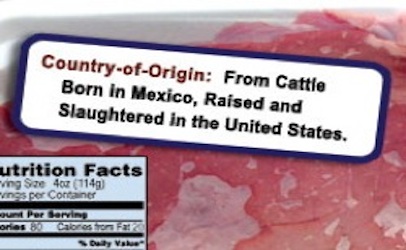
The House just voted to repeal Country-of-Origin labeling (COOL) for beef, chicken, and pork. The reason that this happened makes sense but the fact that it happened at all makes no sense. But first, a little background.
COOL was first signed into law in 2002 as part of the Farm Security and Rural Investment Act as a voluntary labeling process. Initially it was intended for the label on fresh beef, pork, and lamb products. In 2003 it became mandatory to label COOL. By 2008 the program was expanded and the current labeling requirement covers beef, veal, lamb, chicken, fish, shellfish, pork, goat, macadamia nuts, pecans, ginseng, peanuts, and perishable agricultural commodities. For the purposes of this post I'm focusing on meat.
The intent of COOL was to clearly identify the chain of supply for fresh food. If an item was destined for a processing plant where it would be significantly changed for example, turning fresh beef into a shepherd's pie, that process would remove the need for COOL. The FDA's definition of processed is so broad that many foods were able to avoid using the label.
What does the label look like? It's confusing. There's no clear standards for a COO label. It can be any size, font, color, location on the package. There are standards about what it has to say but even there it can get a little confusing. The Agricultural Marketing Service (AMS) which is part of the United States Department of Agriculture (USDA) does publish a list of the standard terms acceptable for labeling which covers country names and their abbreviations as well as labeling options covering the chain of supply from birth to either slaughter or slaughter and import. Prior to May 2013 even that was less than clear due to commingling. This was the practice of allowing a single label for meat that has more than one country of origin as long as it was processed in the same slaughterhouse all on the same day. Commingling is no longer allowed which should make for clearer labeling of where animals were born, raised, and slaughtered.
In theory the ability to know where your meat is coming from, where it was raised, is a good one. In practice COOL does not work as advertised. I believe part of this is due to the lack of consistency with labeling, a lack of clear understanding for the consumer, and too many loopholes. I also believe that people really are paying more attention to where their food comes from, how it's raised, and where it is processed. They want to know but are confused about the label due to inconsistent and unclear implementation.
The supply chain can sometimes become very convoluted. As the Horsemeat Gate Scandal in the early part of 2013 highlighted, our food can travel a great distance before it lands on our dinner plate. This unfortunate incident where horesemeat was fraudulently sold as beef only revealed the scale of travel for processing not for birth and rearing. Obviously because it was processed it also would have been able to sidestep a COOL process had one been in place.

Horsemeat Gate also revealed a significant breakdown in the traceability of where our meat comes from. The EU is currently investigating possible solutions to prevent this from happening again. Something along the lines of COOL comes to mind, but only if it's properly implemented. It's important to note that this was by no means a stand-alone incident, it was simply the biggest, most reported on episode. There have also been incidents in China such as a 2013 investigation into the use of rat, mink, and fox meat being adulterated and sold as mutton. And it doesn't seem to get better. Just last year there was a recall in China of donkey meat contaminated with fox. These incidents, by the way, give serious pause to the thought of eating any meat from China. And yet the USDA has approved the import of American raised chickens to China for processing and then re-imported for sale. Currently the transportation costs for poultry are too expensive and it does not appear that any American producers are doing this. Unfortunately, if they do, it may be hard to know because the chicken would come back in a processed form that would thereby allow it to avoid COOL.
So why is COOL on the chopping block? In a single word, politics. Canada and Mexico filed a complaint with the World Trade Organization (WTO) claiming that COOL was discriminatory. It is interesting to note that China is listed as one of the third parties in the complaint. Canada contends that meatpackers offer lower prices for their products. Not because they are lesser quality, but because the meat packers don't want to track and label the meat. Canadian producers claim this has cost them nearly US$1 billion. Unfortunately the WTO agreed with the plaintiffs. This is the second time they've done so, the first time the US reworked COOL but apparently this was not perceived as being enough. Now Canada and Mexico are threatening import taxes on certain products from the United States unless COOL is repealed. Due to fears about trade the House has voted to dismantle COOL altogether. The next step is to go before the Senate.
This is a huge mistake. While the process of modification on any legislation is certainly challenging, the fact remains that this program was never thoroughly laid out or utilized to begin with. Given the increasing issues with food contamination, adulteration, mis-labeling, and because of sourcing concerns it makes sense to keep COOL and more clearly identify the supply chain for our food. Consumers want to know, and have the right to know, where their food comes from.
